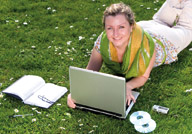Tips to Becoming a Technology-Savvy Shopper
 Many adults grew up in a world without the Internet, cell phones or personal computers, and often find themselves lost in the ever-changing realm of technology.
Many adults grew up in a world without the Internet, cell phones or personal computers, and often find themselves lost in the ever-changing realm of technology.
Today, students carry laptops and numerous gadgets that ring, buzz and sing, which leaves a number of adults at a loss when it comes to shopping for the younger generation.
So, in an effort to help parents and adults navigate the technology maze, we’ve compiled a list of buying tips.
* Cell Phones vs. Smartphones: With the ability to send and receive calls and the ever-popular text messages as well as take photographs and browse the Internet, both cell phones and smartphones have similar features.
Smartphones, like the Blackberry and Treo, take things one step further by including full keyboards and software that tracks appointments, manages contacts and performs a host of other business-level functions.
While smartphone software can be useful, it can also become a distraction for students. So, unless your student is a budding entrepreneur, a standard cell phone with a plan that includes both calling and texting is ideal.
* Mac vs. PC: Mac or PC? While PCs are more widespread, Macs are user-friendly and perfect for editing and downloading photos, music and videos. Macs also tend to be more secure because they are less likely to become infected with annoying viruses or spyware. PCs, however, are more affordable and have a wider variety of programs and games available.
But who says you have to choose? You can get the best of both worlds by purchasing a Mac computer and downloading Parallels Desktop for Mac (www.parallels.com/en/product/desktop). The software enables users to run both Windows and Mac applications at the same time on any new Mac computer.
* Ask the Experts: Hopefully you’re feeling more prepared to take a stroll through your local electronics store. If need more ammunition, you can also consult feedback from students and teachers.
Each year, Project Tomorrow, through its NetDay Speak Up research project, surveys students in kindergarten through 12th grade, as well as teachers, to determine which technologies they are using. For more information, visit www.tomorrow.org.
Comments are closed.